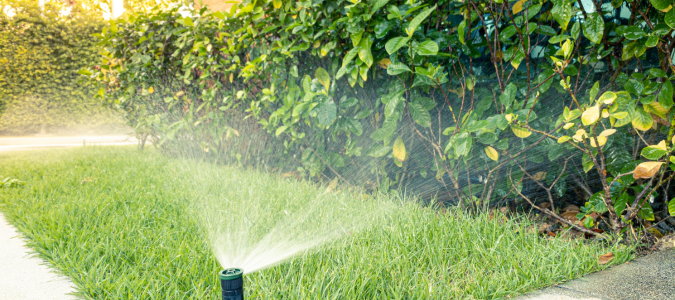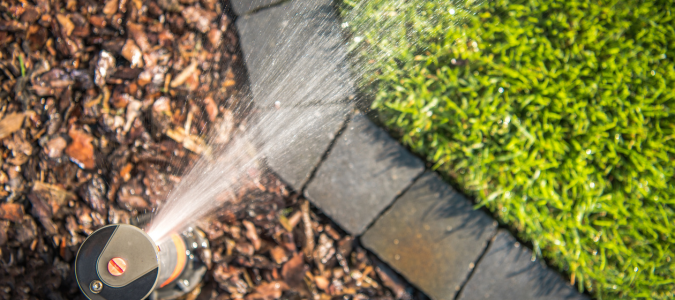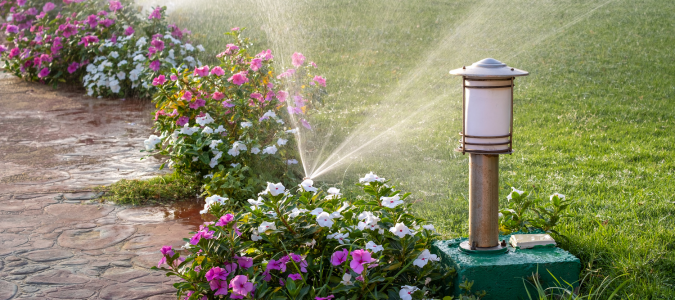When it comes to having the lawn of their dreams with lush flower beds and a perfectly manicured yard, many homeowners have to make a choice between spending their time maintaining their lawn or finding a way to automate a lot of the care.
With our hot summers, a sprinkler system seems like a perfect solution. Watering your yard can take hours every week, and missing even one day can damage your lawn on sweltering days. It can mean you take twice as long the next day to make up for the day you missed. Sometimes even that isn’t enough to save your plants.
Sprinklers are the obvious solution. Oscillating sprinklers that arc back and forth overhead are quiet but must be moved regularly. These sprinklers do a great job covering a rectangular patch evenly, but that’s all they do. They can’t be tuned for oddly shaped areas and don’t move from area to area.
Rotary sprinklers are another great solution. These sprinklers can be adjusted to cover just about any space and spray water further than any other sprinkler head. However, they still don’t move from area to area.
What about those sprinklers that use water pressure to slowly roll across your lawn? Unfortunately, they’re not built to pull a heavy water hose across your lawn without problems. They’re known for getting pulled to one side and winding up where you don’t want them.
These options are just a small step above holding the hose every evening. They won’t get you the relief you want—a low-maintenance yard that works and looks great year after year.
How to Design a Sprinkler System
If you’re interested in designing your own sprinkler system, here’s a quick rundown of what you’ll need:
- Grid paper to map out your yard
- A laser rangefinder or a rolling measure
Then, draw in the boundaries of your property. Consider these areas:
- House
- Driveways and sidewalks
- Outbuildings
- Flower beds
- Trees
- Garden
- Existing water access
Be Careful of Buried Utilities
Your next step should be to call your local utility location service. This is vital for a sprinkler system since you’ll need to dig trenches around your property. You certainly don’t want to drive a shovel into one of your utilities. In the US, you can call 811 to arrange line-locating services.
You’ll also want to draw in the utility lines on your map. Another thing you should consider is that line location is only available when the utility enters your house. If you have, for example, electricity and water in a shed or backhouse, those lines will not be located. Homeowners are expected to stay at least 18 inches away from utility lines. You may need to call a professional landscaper to help locate those lines.
Planning for the Pressure
It’s important to learn about your yard’s water pressure. Sprinklers are generally designed to deliver a certain amount of water in a specific area over time. That assumes your water pressure is “normal.” But “normal” water pressure can range from 45 to 80 pounds psi. If the pressure at your outside spigot is low, you might consider having a professional run a new one. Installing a new spigot can also allow you to tailor your sprinkler system better since you can install it wherever works best for your plans. Determining your existing pressure is another job your lawn service professional can handle. They can also advise how often you should water your lawn with a sprinkler system.
The Different Types of Sprinkler Systems
Next, you need to learn what types of sprinkler emitters are available. You’ll want to know how much area they cover. They’ll contain information so you can know how many of them you can use at once, given your water pressure. The sprinkler heads themselves fall into three types.
Impact Sprinklers
These are the sprinklers that you see on many golf courses. You can cover large areas with these sprinklers because they shoot water back and forth in big arcs. Lawn service professionals will caution you, though. Getting plant leaves wet just before dark often leads to fungus and other disease issues. Wetting the leaves during the day can lead to burning by sunlight. These sprinklers are generally reserved for lawns and can be adjusted to hit specific areas.
Rotor Sprinklers
Rotor sprinklers cover full circles or a portion you set like impact sprinklers. Impact sprinklers tend to be mounted on stands about three feet high for maximum range, while rotors are more commonly pop-up devices used to cover smaller grassy areas.
Low-Pressure Sprinkler Emitters
These sprinklers are designed to cover just one or a few plants. They use your water more efficiently than high-volume rotary and oscillating heads, but it takes more to cover a given area. Different styles offer adjustable coverage delivery so they can be tuned for specific circumstances.
Drip Lines
Drip lines are great for bedding plants. They are irrigation lines with carefully cut notches so they drip uniformly along their length. Drip lines are easy to use since they don’t even get buried. They’re covered by the plants that they water. They offer the most efficient watering system but may not provide enough water for thirsty plants. Since they don’t get buried, drip lines are a good solution if your irrigation system needs to cross over buried utilities.
Getting Into the Zones
The last thing you’ll need to figure out is your watering zones. You typically don’t want to try to water everything at once. Choose areas and map them as discrete zones. For instance, the flower beds around the house might be one or two zones. Then the front yard can be its own zone, the back yard, etc. You’ll want a trench to run from your water source out to each zone. How many sprinklers you need per zone will depend on your yard’s water pressure and water flow.
The irrigation lines should be buried about eight inches deep, but there’s no hard and fast rule. If you use pop-up sprinkler heads, the pop-up housing will dictate how deep the line needs to be.
The sprinkler brand you choose will have instructions for best installation practices; they all tend to be about the same in terms of difficulty. A professional landscaper can help you create and install the best sprinkler system for your yard so you can enjoy an attractive yard again.
Sprinkler System Tips and Tricks
Once you have your sprinkler system, some tips can improve your experience. Use compressed air to blow any water out of the lines at the end of each growing season. The lines are shallow enough to freeze during the winter. Those plastic lines may survive a freeze or two, but any connectors will almost certainly leak afterward. If your system is built on a slope, include a cleanout at the lowest point of each zone. Open the cap and let the water drain out when shutting down the system each fall. That can save having to manipulate an air compressor line to your control head.
You’ll also want to disconnect the controller from the water supply each fall. When you do that, tape up the connector to prevent insects and dirt from entering your system.
If your system is battery-powered, install new batteries every spring when you bring the system back online.
The Reality of the Project
Installing a sprinkler system is doable for some homeowners. That doesn’t mean it’s easy, and it certainly doesn’t mean you have a good chance of getting it right the first time. Novice installations almost always have problems. That’s why more people call in lawn service experts.
Common points of failure include:
- Putting the wrong amount of water in a given area
- Poor performance due to low water pressure or too many emitters
- Failure to properly check all connections for leaks
- Line blowouts due to high water pressure
- Missed areas
- Unequal pressure from the zone’s beginning to end
- Water hammering that can be heard in the house when the system turns on or off
- Not ensuring water reaches all of the plant’s roots
- Failure to protect from freezing in winter
- Emitters clogged due to dirt in lines
How Lawn Care Professionals Can Help
Lawn service professionals know how to avoid these pitfalls and a lot more. Terrains like rocks and slopes can complicate your home sprinkler system. You might be able to use a pond as a water source; you might want to incorporate water catchment on your roofs or even drill a water well for irrigation. All of those, while saving significant money, are often beyond the knowledge of a typical homeowner.
Sprinkler control systems at DIY stores are almost universally timer-based. The newer designs include sensors to tell the controller when an area is dry to activate watering. Depending on how involved you want to get with your irrigation system, lawn care professionals can set you up with systems you can access across the Internet to check the status or be automatically notified of problems.
Irrigation systems are projects that can grow quickly but yield tremendous results when executed properly. However, issues like water pressure and the science of hydraulics complicate home sprinkler installations. Contact a pro if you have an irrigation system that’s not performing as it should or want to look at an irrigation system for your home.
ABC Can Care For Your Sprinklers
Take the guessing game out of designing and caring for your sprinkler system by contacting ABC Home & Commercial Services. Our sprinkler system repair experts can ensure your lawn stays healthy and green. We also offer landscaping services so that you can keep your lawn green in the summer heat.


